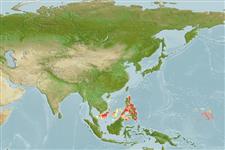Common names from other countries
Teleostei (teleosts) >
Eupercaria/misc (Various families in series Eupercaria) >
Labridae (Wrasses)
Etymology: Paracheilinus: Greek, para = the side of + Greek, chaite = hair + Greek, odous = teeth (Ref. 45335).
More on authors: Randall & Lubbock.
Environment: milieu / climate zone / depth range / distribution range
Ecology
Marine; reef-associated; depth range 12 - 40 m (Ref. 9710). Tropical; 20°N - 5°N
Western Pacific: Philippines.
Size / Weight / Age
Maturity: Lm ? range ? - ? cm
Max length : 7.0 cm TL male/unsexed; (Ref. 90102)
Dorsal spines (total): 9; Dorsal soft rays (total): 11; Anal spines: 3; Anal soft rays: 9 - 10; Vertebrae: 25. Scales with dark brown markings; yellow stripes on postorbital head, continuing onto thorax and abdomen; orange-red when fresh. Males more colorful and larger in size than females; color of males intensify during courtship. Males with its first 4-6 dorsal soft rays prolonged as filaments. Mouth small and oblique. Interrupted lateral line.
Found on bases of steep outer reef slopes, above rubble or coral (Ref. 9710). Found on rubble bottoms that are exposed to strong currents occasionally (Ref. 90102). Occurs in small groups (Ref. 2139) of mix sexes but females outnumber males (Ref. 90102).
Life cycle and mating behavior
Maturities | Reproduction | Spawnings | Egg(s) | Fecundities | Larvae
Oviparous, distinct pairing during breeding (Ref. 205).
Randall, J.E. and R. Lubbock, 1981. Labrid fishes of the genus Paracheilinus, with descriptions of three new species from the Philippines. Jap. J. Ichthyol. 28(1):19-30. (Ref. 2139)
IUCN Red List Status (Ref. 130435)
CITES (Ref. 128078)
Not Evaluated
Threat to humans
Harmless
Human uses
Fisheries: commercial; aquarium: commercial
Tools
Special reports
Download XML
Internet sources
Estimates based on models
Preferred temperature (Ref.
115969): 28 - 28.7, mean 28.5 (based on 12 cells).
Phylogenetic diversity index (Ref.
82804): PD
50 = 0.5000 [Uniqueness, from 0.5 = low to 2.0 = high].
Bayesian length-weight: a=0.00955 (0.00456 - 0.02002), b=3.06 (2.89 - 3.23), in cm Total Length, based on LWR estimates for this (Sub)family-body shape (Ref.
93245).
Trophic level (Ref.
69278): 3.4 ±0.45 se; based on food items.
Resilience (Ref.
120179): High, minimum population doubling time less than 15 months (Preliminary K or Fecundity.).
Fishing Vulnerability (Ref.
59153): Low vulnerability (10 of 100).
